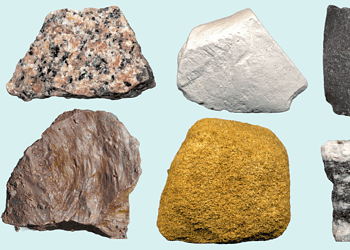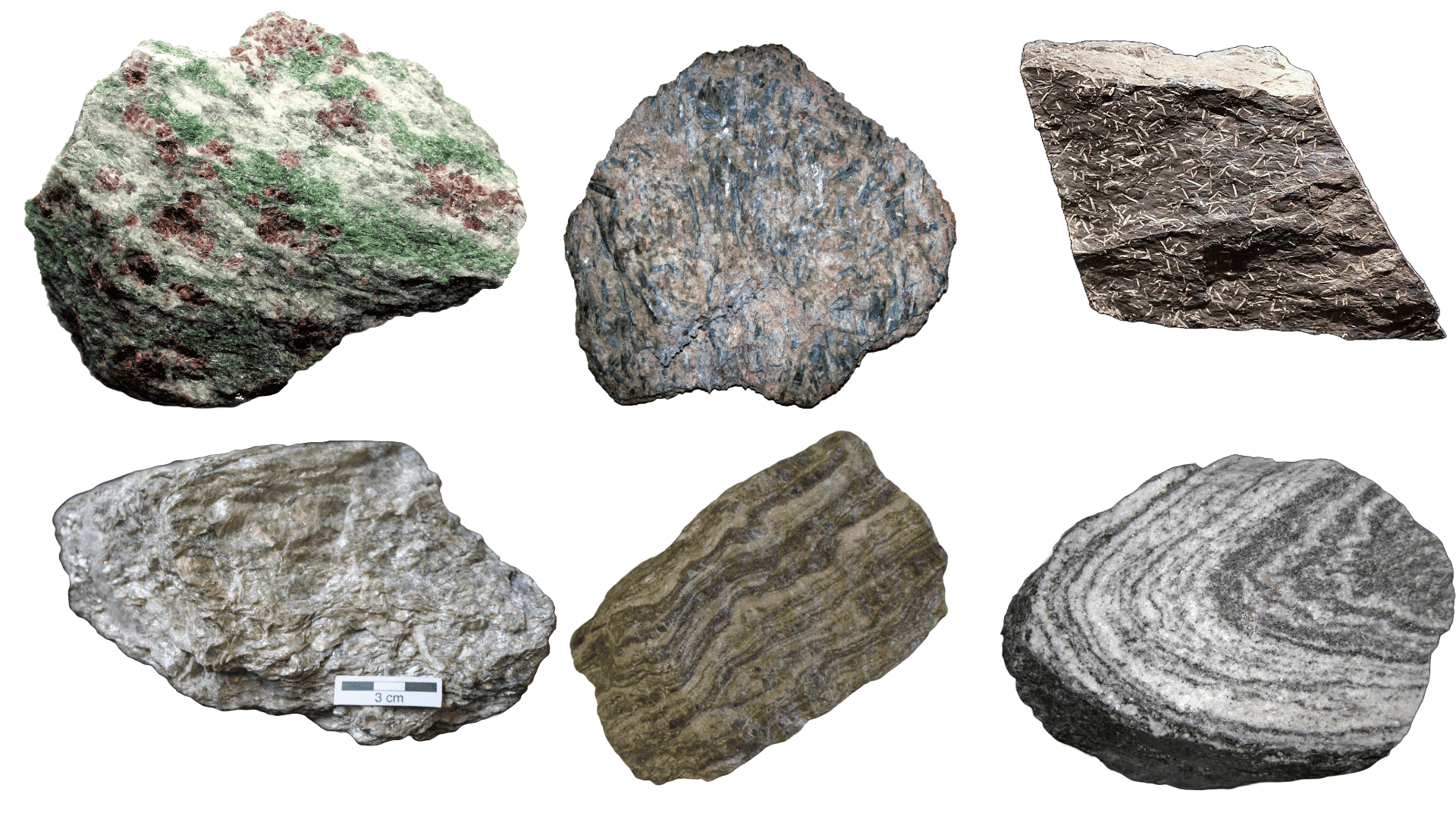
What are metamorphic rocks?
Metamorphic rocks are one of the three main types of rock. They are “changed rocks” that started out as other rocks (whether igneous, sedimentary, or other metamorphic rocks) and have undergone a physical and chemical transformation — a metamorphosis. This process involves high temperatures and pressures. It alters the original struture and/or mineralogical composition of the rock.
During metamorphism, the existing minerals in the parent rock re-crystallize or form new minerals, leading to changes in texture, such as the development of foliation (layering) or a more granular structure. This process often result in a significant alteration of the rock’s original appearance and physical properties.
How metamorphic rocks form
You can take any rock and make it metamorphic. All you need to do is subject it to enough pressure and temperature that it starts to fundamentally change.
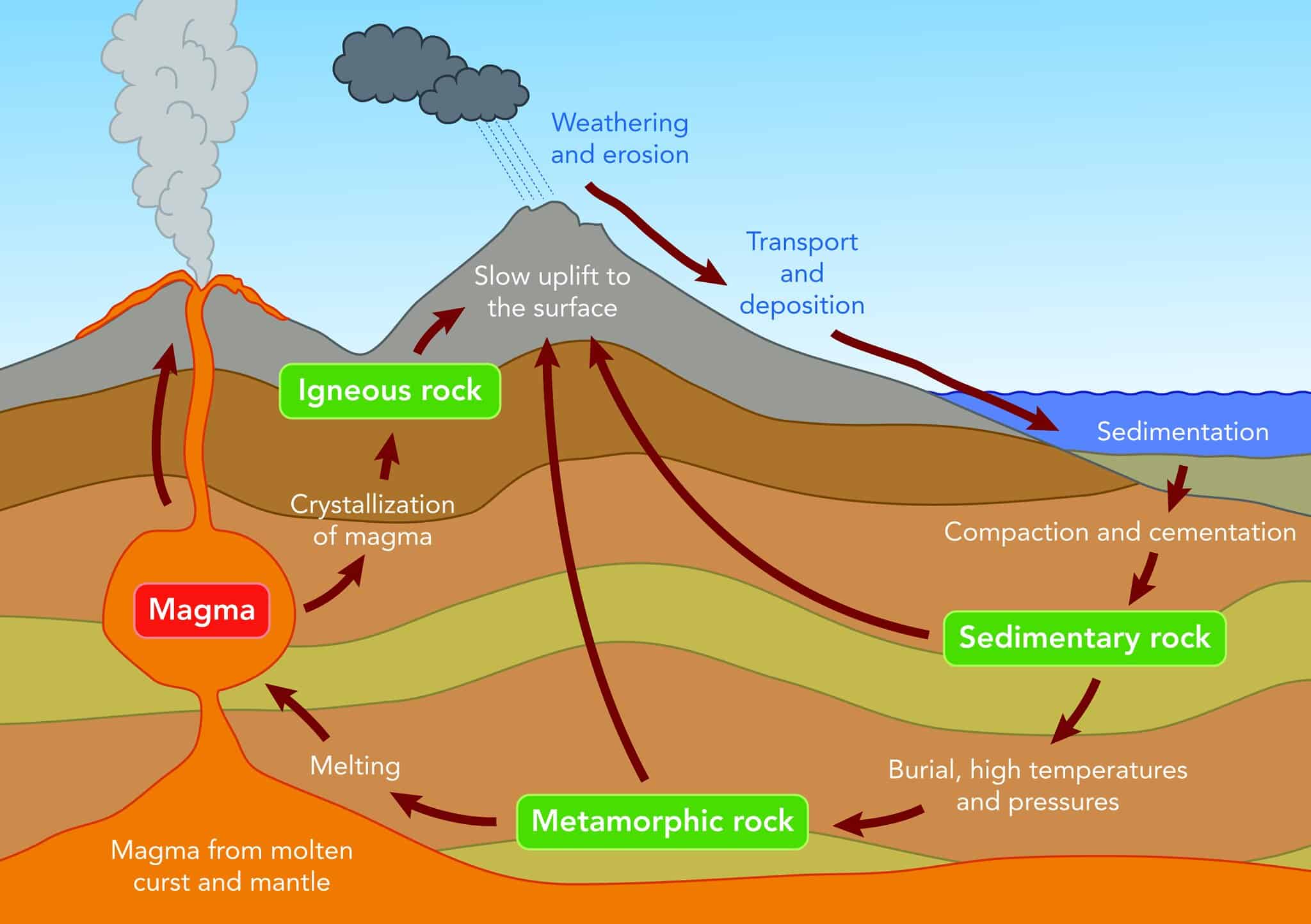
The journey of a metamorphic rock begins with a parent rock, which can be an igneous, sedimentary, or even another metamorphic rock. This rock undergoes profound physical and chemical changes when subjected to high temperatures and pressures, conditions often associated with tectonic plate movements and deep burial beneath the Earth’s surface.
The parent rock is called a protolith — or the “original stone”. Sometimes, you can tell what was the parent rock (or at least gain some clues about it). But the resulting metamorphic rock is different from the original one, whether in texture, structure, chemical composition, or all of the above.
The role of heat and pressure
Heat and pressure are the primary agents driving metamorphism. Temperatures range from 150 to around 1,000 degrees Celsius — anything lower, and there wouldn’t be enough heat to change things; anything higher, and you’d end up with igneous rocks.
The other aspect is pressure. High temperatures and the immense pressures of thousands of atmospheres work together to rearrange the minerals in the parent rock. This process can create entirely new minerals and textures, a phenomenon akin to a caterpillar transforming into a butterfly.
Heat is the primary driver of metamorphism. It can originate from various sources, including the geothermal gradient (the increase in temperature with depth in the Earth), heat generated by the decay of radioactive elements, or the intrusion of hot magma into cooler surrounding rocks. As temperature rises, it can break chemical bonds in minerals, facilitating the growth of new minerals that are stable at higher temperatures.
Pressure increases with depth in the Earth and can significantly affect rock formation. It can be lithostatic (uniform pressure applied in all directions) or differential (pressure greater in one direction). Differential pressure, often associated with tectonic forces, leads to the alignment of minerals in the rock, resulting in foliation, a key characteristic of many metamorphic rocks.
Fluids, often water with dissolved ions, also play a significant role in metamorphism. They can facilitate the movement of ions, aiding in the growth of new minerals and the alteration of existing ones — changing the chemistry of the rocks. This fluid-induced metamorphism can result in the formation of unique mineral assemblages and textures.
This metamorphism involves a solid-state recrystallization of the rock’s minerals. This process can happen at various temperatures and pressures, and therefore, there are a lot of different types of metamorphic rocks. The diversity of these rocks reflects the variety of their parent materials and the range of conditions under which they form.
Some of the most common metamorphic rocks
Before we get into the details of how metamorphic rocks form and what role they play in geology, here are some of the most common metamorphic rocks.
- Slate: Originally a shale, slate is fine-grained and known for its ability to split into flat sheets. It’s commonly used in roofing and flooring.

- Gneiss: Originating from granite or sedimentary rock, gneiss is notable for its banded appearance, created by the segregation of different minerals into layers.
- Schist: Formed from mudstone or shale, schist is characterized by its shiny, layered appearance and rich mineral content, including garnet, mica, and quartz.
- Marble: This rock starts as limestone or dolostone and transforms under heat and pressure. Known for its beautiful veining and used extensively in sculpture and architecture.
- Quartzite: Formed from quartz-rich sandstone, quartzite is extremely hard and resistant to weathering. It’s often used in decorative stone works.
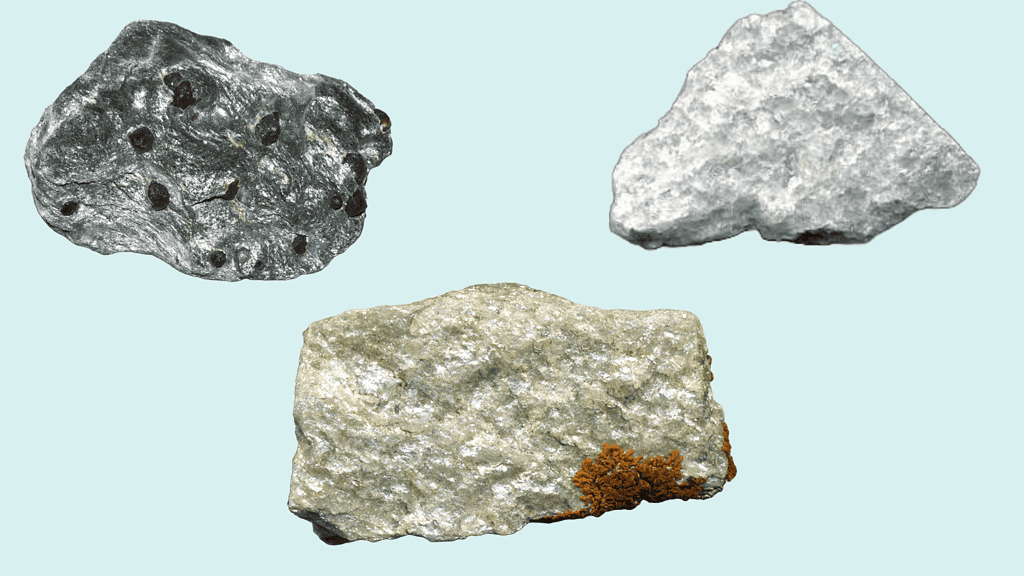
- Phyllite: A fine-grained rock that evolves from slate as it undergoes further metamorphism. It has a slightly glossy sheen and a wavy surface, often used in decorative stone works.
- Amphibolite: Formed from basalt or gabbro, amphibolite is characterized by a predominance of amphibole minerals (like hornblende) and plagioclase feldspar. It’s used in construction and as a decorative stone.
- Serpentinite: Derived from the metamorphism of ultramafic rocks from the Earth’s mantle, serpentinite is composed of minerals from the serpentine group. It has a distinctive green color and is used in decorative and architectural applications.
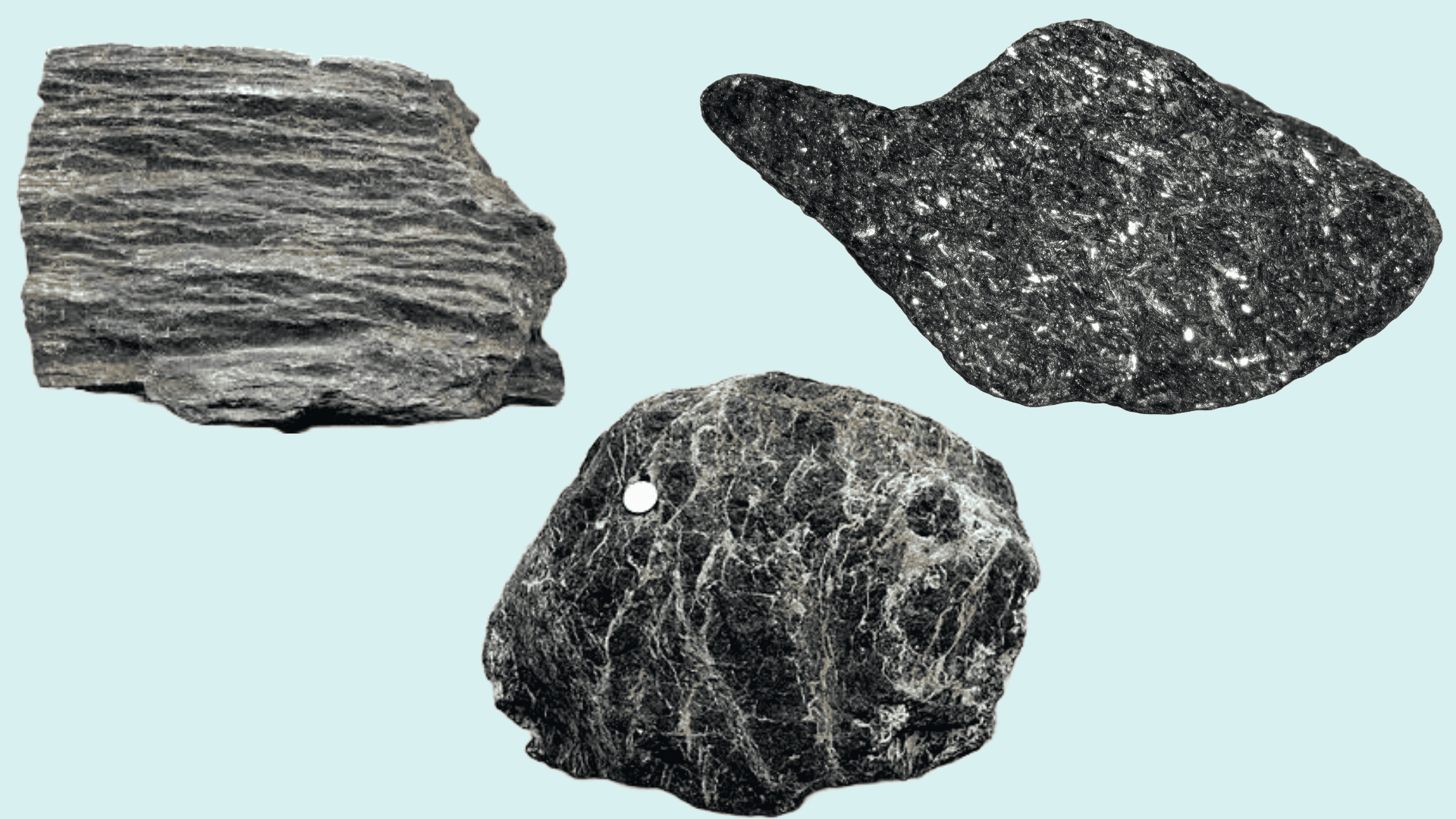
- Migmatite: A mixed rock composed of metamorphic and igneous parts. It forms under high-temperature conditions where partial melting occurs. Its complex texture reflects a mix of solid and molten rock history.
- Eclogite: This is a high-pressure, high-temperature metamorphic rock formed from basalt or gabbro. It’s characterized by a striking green and red appearance due to its main minerals: green omphacite (a type of pyroxene) and red garnet. Eclogite forms in very specific conditions.
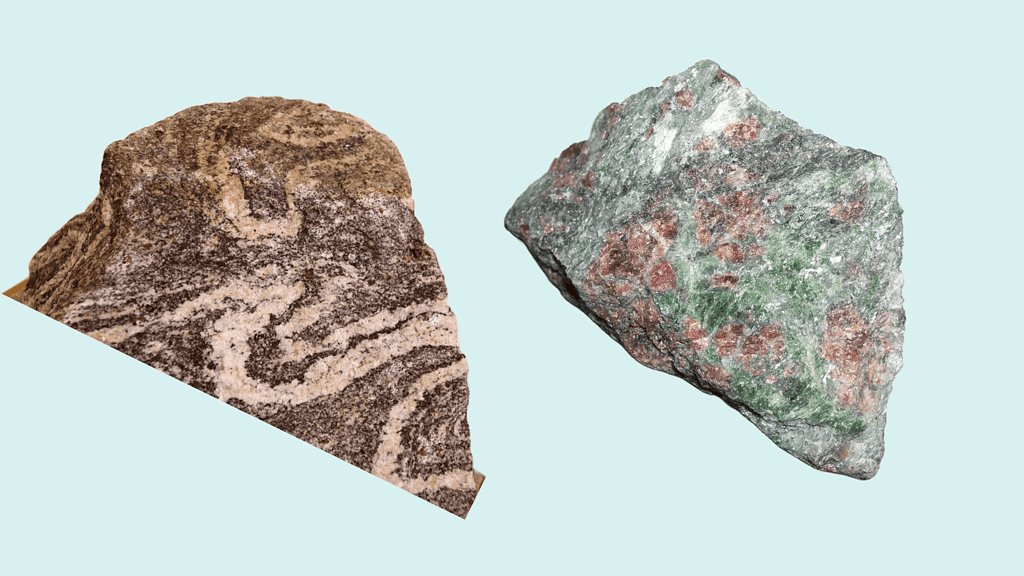
Types of metamorphism
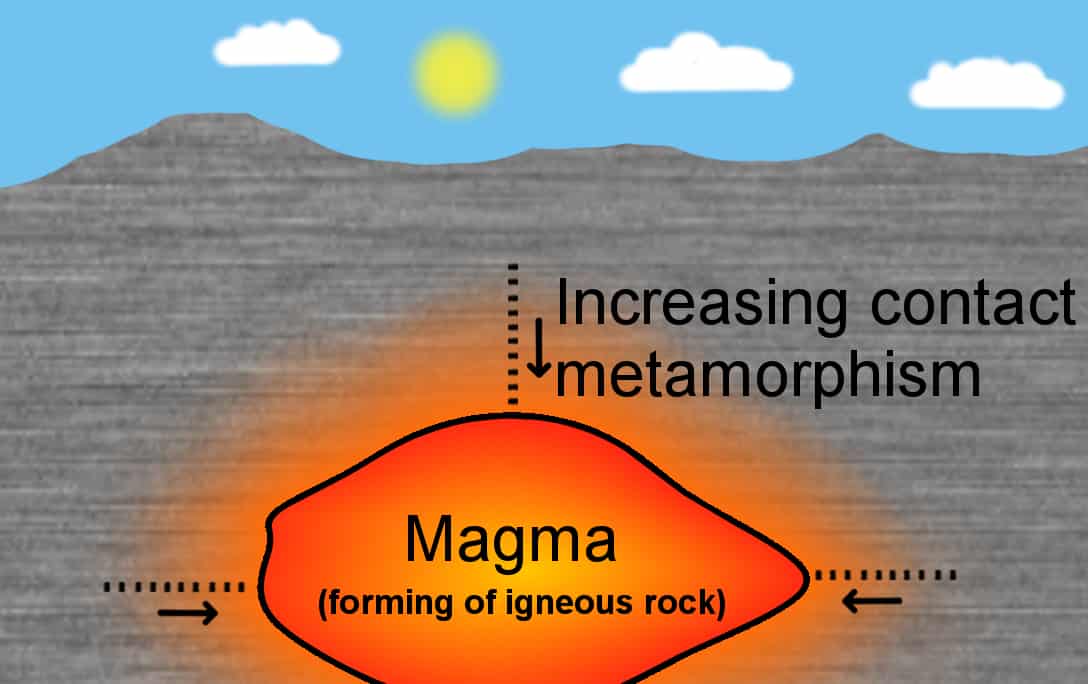
The diversity of metamorphic rocks is a direct reflection of the varying conditions under which they form. There are three main types of metamorphism, based on the geological processes that create the rocks and minerals.
Regional Metamorphism
This is the most common type and occurs over large areas, typically associated with mountain-building processes where tectonic plates collide. The immense pressure from the collision and the heat generated by the thickening crust lead to widespread metamorphic changes. Regional metamorphism produces a wide range of metamorphic rocks, from low-grade (like slate) to high-grade (like gneiss).
Contact Metamorphism
This occurs when hot magma intrudes into cooler surrounding rock, known as the country rock. The heat from the magma raises the temperature of the surrounding rock, causing changes in its mineral structure. Contact metamorphism usually affects a smaller area compared to regional metamorphism and often results in the formation of non-foliated rocks like marble and quartzite.
Dynamic Metamorphism
This type occurs in fault zones where rocks are subjected to high differential pressure and shear stress. The intense grinding and crushing along fault lines can lead to the formation of mylonites, rocks that are characteristically fine-grained and foliated, a result of the extreme physical deformation.
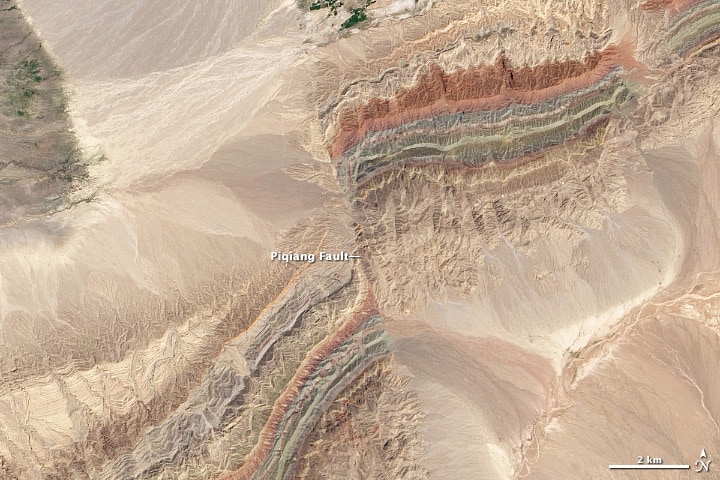
In addition, other localized phenomena can also create different types of metamorphism.
- Cataclastic Metamorphism: This process involves the mechanical deformation of rocks along fault zones, where friction generates heat and causes the rocks to crush and pulverize. It’s a relatively rare phenomenon, confined to narrow zones where this shearing happens.
- Hydrothermal Metamorphism: This occurs when rocks (especially basaltic ones) are altered by hot, high-pressure fluids. This leads to the formation of hydrous minerals like talc, chlorite, serpentine, and others. Rich ore deposits often form as a result of this process.
- Burial Metamorphism: This happens when sedimentary rocks are buried deeply relatively quickly, reaching temperatures over 300°C without significant stress. Under these conditions, new minerals like Zeolites form, though the rock doesn’t seem obviously metamorphosed. This overlaps with diagenesis and can transition into regional metamorphism under higher temperatures and pressure.
- Shock Metamorphism (Impact Metamorphism): This is caused by the extreme pressures from events like meteorite impacts or massive volcanic explosions. These pressures can create unique high-pressure minerals like coesite and stishovite, as well as specific textures in the rocks, such as shock lamellae and shatter cones.
Here are some metamorphic rocks based on how they form and the type of metamorphism.
| Metamorphic Rock | Type of Metamorphism | Parent Rock | Characteristics |
|---|---|---|---|
| Slate | Regional | Shale | Fine-grained, splits easily, usually gray |
| Schist | Regional | Various, including shale and igneous rocks | Medium to coarse-grained, layered, contains mica |
| Gneiss | Regional | Various, including granite and sedimentary rocks | Banded, coarse-grained |
| Marble | Regional/Contact | Limestone or Dolomite | Crystalline, various colors, often veined |
| Quartzite | Regional | Quartz sandstone | Extremely hard and resistant, glassy luster |
| Phyllite | Regional | Shale or Mudstone | Fine-grained, lustrous sheen, foliated |
| Serpentinite | Hydrothermal/Contact | Ultramafic rocks like peridotite | Smooth, green color, often veiny |
| Hornfels | Contact | Various, often shale or clay-rich rocks | Dense, fine-grained, non-foliated |
Types of metamorphic rocks
Metamorphic rocks come in an array of types, each with unique characteristics and formation stories. There are multiple ways of classifying metamorphic rocks. Here are the most common ones.
Texture-Based Classification
There are two main types of metamorphic rocks that dominate the scene: foliated and non-foliated metamorphic rocks.
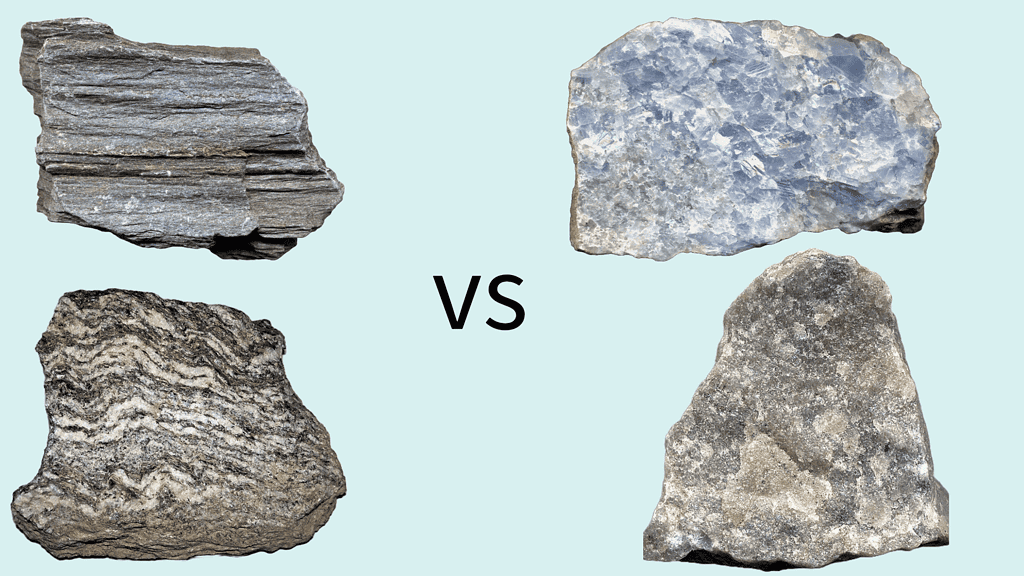
Foliated Metamorphic Rocks are known for their layered or banded appearance, a result of the alignment of mineral grains under directional pressure. This category includes rocks like slate, formed from shale; schist, which often begins as phyllite; and gneiss, derived from granite or volcanic rock. Each of these rocks reveals the intensity of metamorphism they’ve undergone, from mild to extreme.
Non-Foliated Metamorphic Rocks lack a layered structure. These rocks, such as marble (originating from limestone) and quartzite (originating from sandstone), form under conditions where pressure is applied equally from all directions, or where the parent rock’s composition doesn’t allow for layering.
Examples of Foliated Metamorphic Rocks
These rocks have a layered or banded appearance, resulting from the alignment of minerals under directional pressure. Examples include:
- Slate: Very fine-grained, results from the metamorphism of shale.
- Phyllite: Slightly coarser than slate, with a sheeny surface.
- Schist: Medium to coarse-grained, characterized by prominent schistosity due to large mica flakes.
- Gneiss: Coarse-grained, distinguished by its banded appearance, resulting from high-grade metamorphism.
Examples Non-Foliated Metamorphic Rocks
These rocks lack a layered structure, often formed without significant pressure or from minerals that don’t exhibit alignment. Examples include:
- Marble: Formed from limestone or dolomite, it’s primarily composed of calcite or dolomite crystals.
- quartzite: Formed from sandstone and dominated by quartz.
- Hornfels: Formed by contact metamorphism, characterized by a dense, hard texture.
Mineral Composition-Based Classification
The other main way to classify metamorphic rocks is by looking at the minerals they comprise of.
Mafic Metamorphic Rocks
These rocks contain a high proportion of iron and magnesium-rich minerals. These are generally darker-hued minerals such as amphibole, plagioclase, or olivine. Examples:
- Greenschist: Contains chlorite, actinolite, and other green minerals, typically formed under low-grade metamorphic conditions.
- Amphibolite: Higher-grade than greenschist, predominantly composed of amphibole and plagioclase.
Pelitic Metamorphic Rocks
Derived from mudstone or shale, these rocks are rich in aluminum silicate minerals. Examples:
- Slate, Phyllite, Schist: These can be pelitic if they originate from shale.
Calcareous Metamorphic Rocks
Originating from limestone or dolomite, these are rich in calcite or dolomite. Examples:
- Marble: The most common calcareous metamorphic rock.
Quartzo-feldspathic Metamorphic Rocks
Derived from sandstones or granitoid rocks, rich in quartz and feldspar. Examples:
- Gneiss: If it originates from granitoid rocks or high-grade sandstones.
Metamorphic facies
If we want to truly understand metamorphic rocks, we need to consider the concept of a facies.
A metamorphic facies is a set of mineral assemblages in metamorphic rocks formed under a similar range of pressures and temperatures. The facies concept helps geologists interpret the metamorphic history of rocks based on their mineralogical composition. The facies is typically described in the form of a pressure-temperature chart.
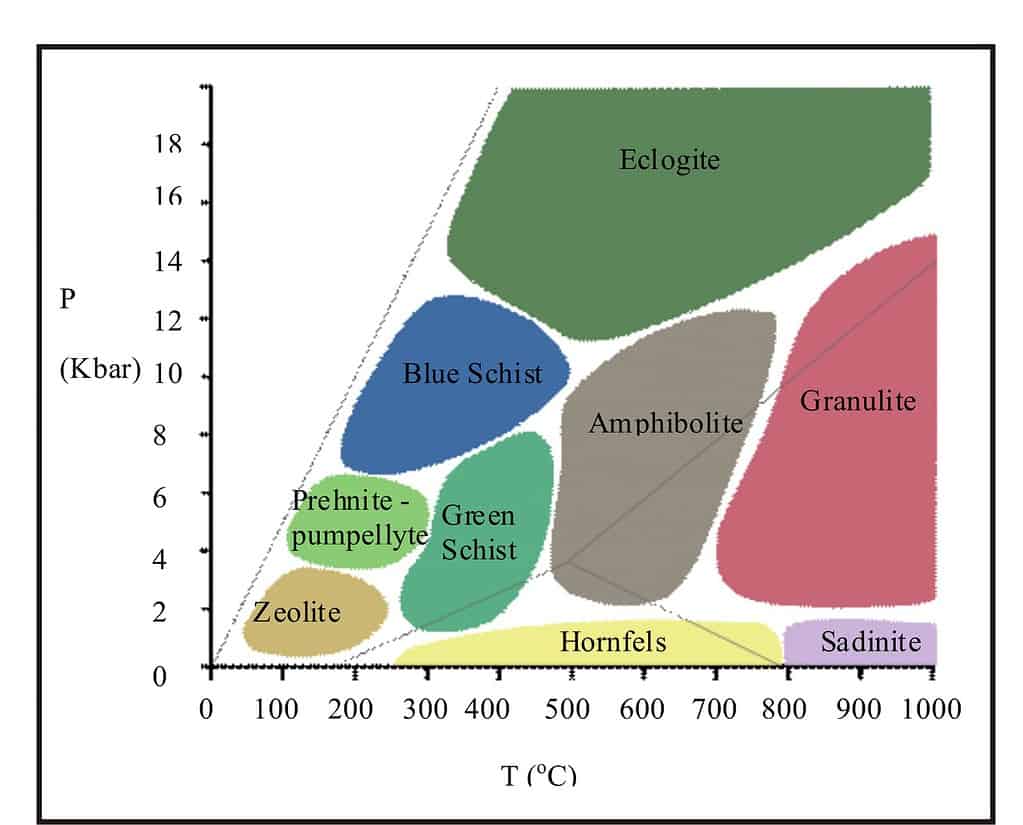
Each facies represents a specific set of physical conditions, and the transitions between them can often be gradual. The facies concept is integral in understanding the tectonic processes and environmental conditions that shape the Earth’s crust. Different facies are associated with different tectonic settings such as subduction zones, continental collision zones, and areas affected by igneous intrusions.
Here’s an overview of the main metamorphic facies (though keep in mind that there are a few others):
- Zeolite Facies: Represents the lowest grade of metamorphism, typically found in oceanic crust and associated with low temperatures and low pressures.
- Greenschist Facies: Characterized by the presence of minerals like chlorite, actinolite, and epidote. This facies forms under low to moderate temperatures and pressures.
- Blue Schist Facies: Identified by the presence of blue amphibole (glaucophane), it forms under high pressures and relatively low temperatures, often associated with subduction zones.
- Eclogite Facies: Represents very high-pressure conditions, typically found in subduction zones. It’s characterized by an assemblage of garnet and omphacite (a type of pyroxene).
- Amphibolite Facies: This is a facies with medium to high-grade metamorphic rocks. The amphibolite facies is notable for the presence of amphiboles (like hornblende) and plagioclase. It forms under moderate to high temperatures and pressures.
- Granulite Facies: Represents the highest grade of metamorphism, characterized by high temperatures and pressures. Rocks in this facies often contain pyroxenes, garnet, and silicate minerals devoid of water.
- Hornfels Facies: Associated with contact metamorphism, this facies forms due to the heating of rocks by an igneous intrusion. The resulting rocks are fine-grained and non-foliated. This type of rock has a variety of mineral assemblages depending on the original rock composition.
Metamorphic rocks in geology
This type of “changed” rocks aren’t just fascinating geological phenomena; they hold crucial clues about Earth’s history and processes.
By studying metamorphic rocks, geologists can decipher the conditions that prevailed deep within the Earth at different geological times. This knowledge helps scientists understand the movement and interaction of tectonic plates, the formation of mountains, and the history of our planet’s crust.
Metamorphic Rocks and Plate Tectonics
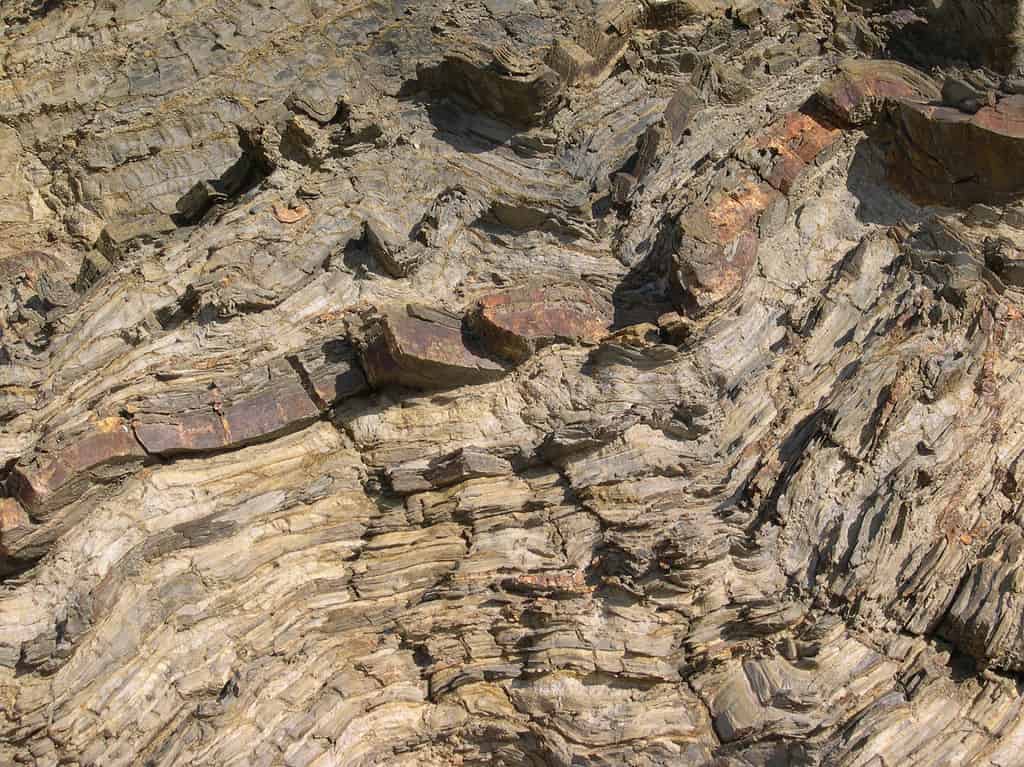
Metamorphic rocks can be found in many places around the planet. The distribution of metamorphic rocks is intimately linked to the theory of plate tectonics. The movement and interaction of tectonic plates create the conditions necessary for metamorphism. Subduction zones, where one plate dives beneath another, are hotspots for metamorphic activity, leading to the formation of high-pressure, low-temperature rocks like blueschist.
Mountain building events, such as the formation of the Himalayas, are prime examples of regions where regional metamorphism is prevalent. The immense pressure exerted during these collisions results in the widespread transformation of rocks, giving rise to some of the most spectacular metamorphic formations.
Uses for metamorphic rocks
Metamorphic rocks have various uses in economic and industrial contexts. In construction, slate and gneiss are used for their durability and aesthetic appeal, suitable for roofing, flooring, and landscaping. Marble, another metamorphic rock, is notable for its beauty and versatility, widely used in sculptures, buildings, and decorative applications, exemplified by the Taj Mahal and Michelangelo’s David.
In industry, talc from metamorphic rocks like soapstone is vital for its lubricating properties, used in machinery, baby powder, and food additives. Garnet, known for its hardness and abrasive qualities, is employed in sandblasting, waterjet cutting, and sandpaper. Metamorphic rocks also source precious gemstones like rubies and sapphires, significant for the jewelry industry and collectors.
Environmentally, metamorphic rocks play a role in soil formation by contributing minerals that enhance fertility and support ecosystems. They also shape landscapes and influence climate patterns, such as mountain ranges affecting wind and precipitation.
A constant geological metamorphosis
In conclusion, metamorphic rocks play a vital role in shaping our understanding of Earth’s geological processes and history. These rocks, formed through intense heat, pressure, and fluid interaction, provide a unique window into the dynamic forces that shape our planet’s crust. The variety of metamorphic rocks, from slate and marble to gneiss and schist, is a testament to the complexity and diversity of geological conditions experienced over Earth’s history.
These rocks have significant economic, cultural, and environmental impacts. They are integral in construction, art, and industry, providing materials like slate for roofing, marble for sculpture and architecture, and minerals like talc and garnet for various industrial applications. Furthermore, gemstones such as rubies and sapphires, formed in metamorphic environments, have considerable economic appeal.
Moreover, metamorphic rocks contribute to soil formation, impacting agriculture and ecosystems. Their weathering releases minerals that enrich soils, supporting plant growth and biodiversity. The formation and distribution of metamorphic rocks are closely tied to the movement of tectonic plates, offering insights into the ongoing evolution of the Earth’s surface.
